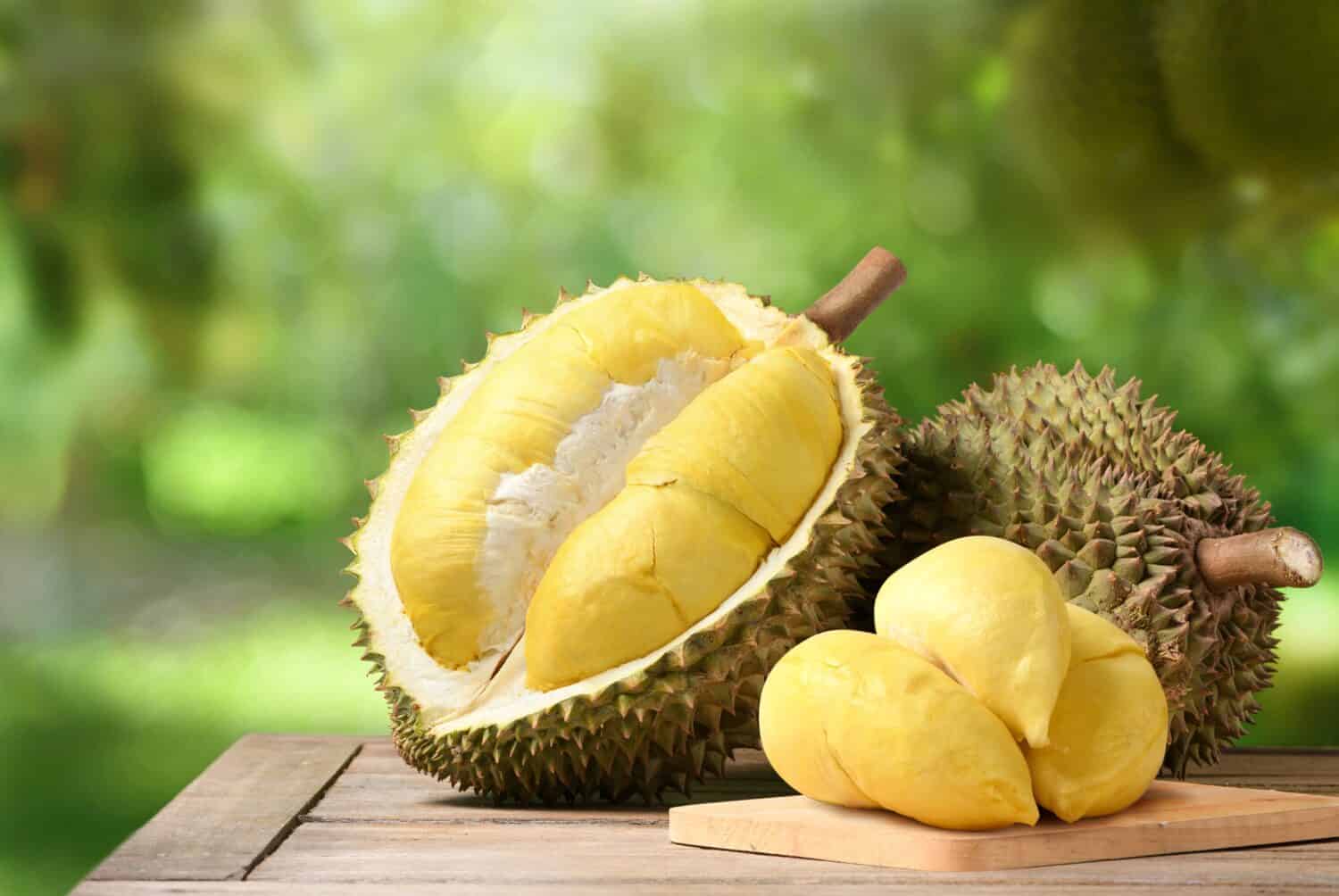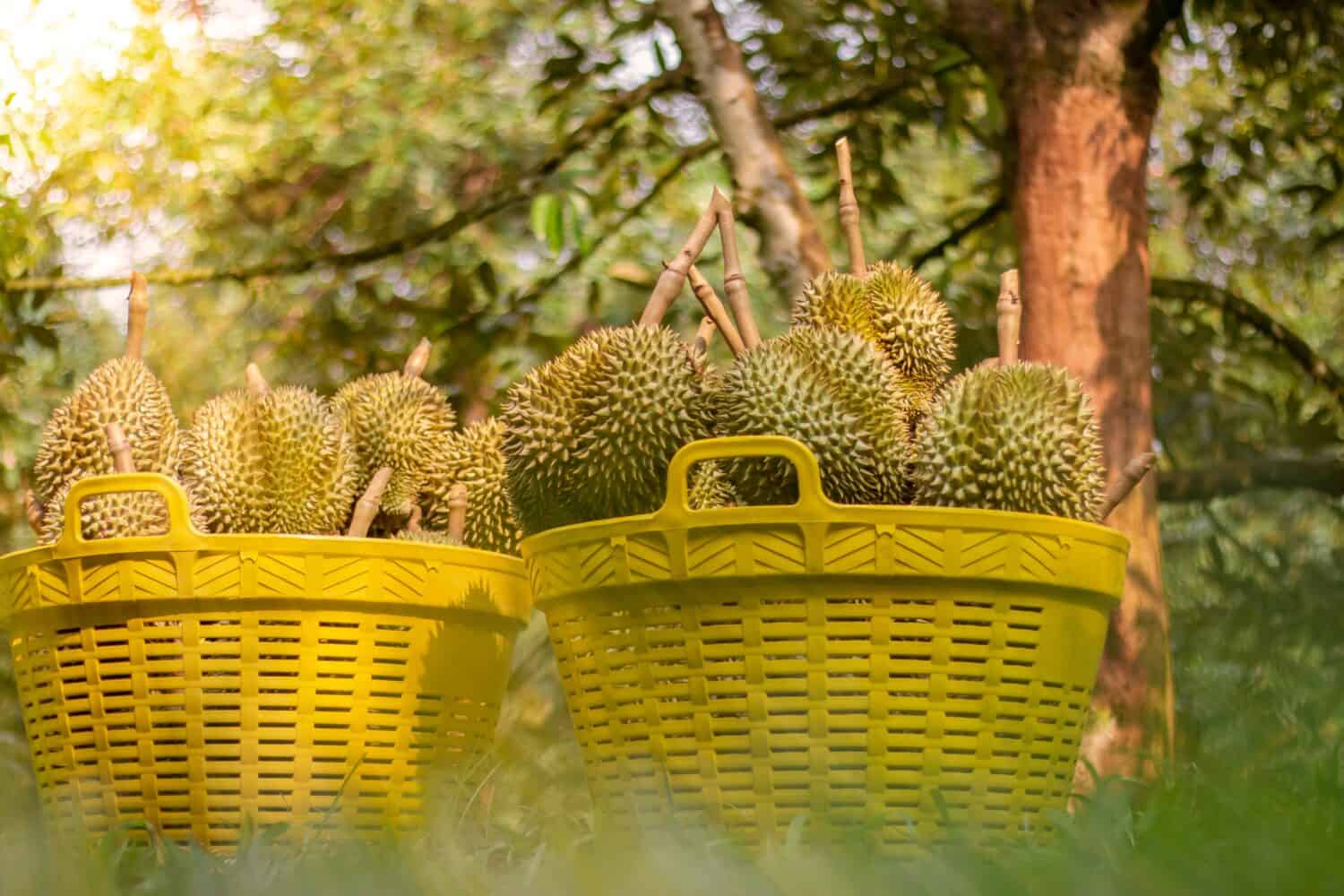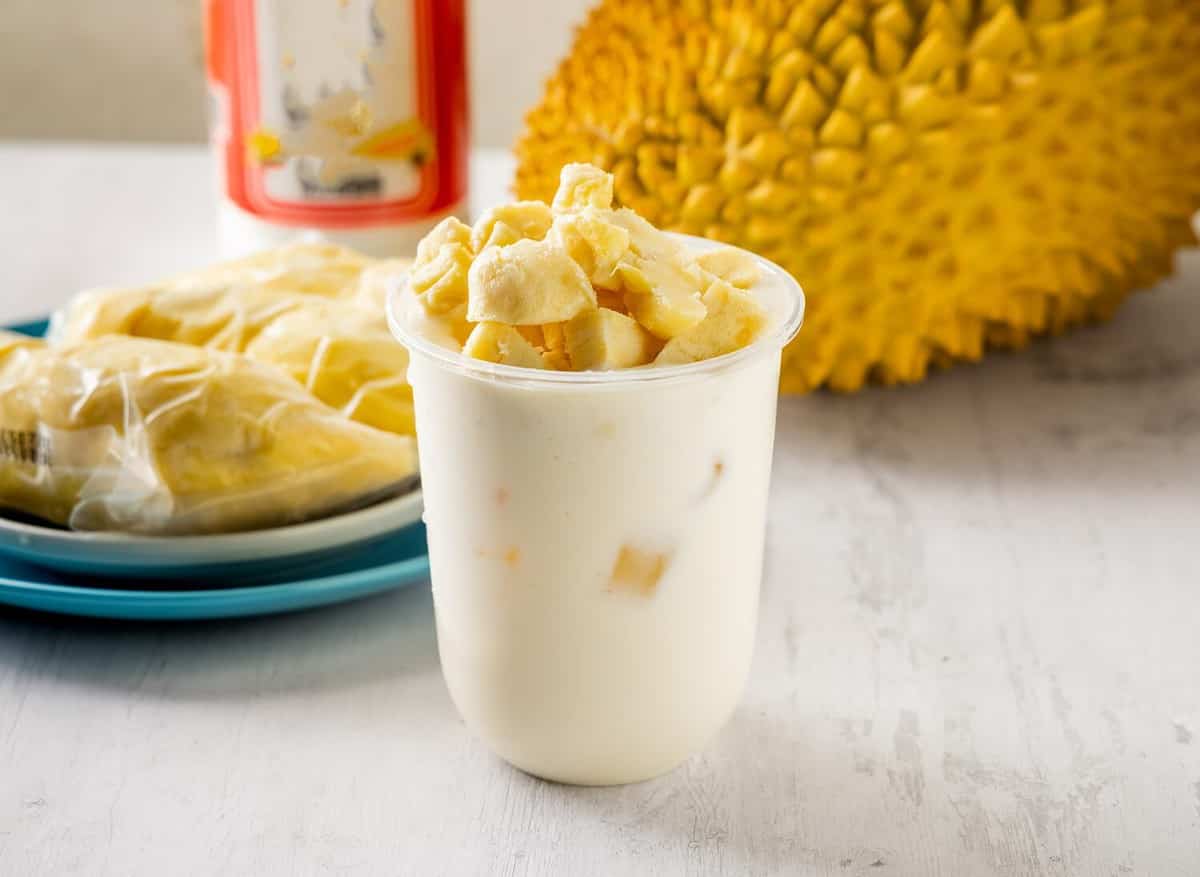While you may spot several different types of unique fruits at your local grocery store, one you've likely never come across is durian. However, you may have seen this fruit's signature spiky and greenish-brown look at your nearest Asian market. Or perhaps you've heard of it and simply wondered what it was.
Durian is a fruit classified by its unique odor and look. It's grown and harvested primarily in Southeast Asia but continues to increase in popularity in other areas of the world, including the United States.
But what do we know about this fruit? From its taste to its odor and how you can use it in recipes at home, here's everything you need to know about durian, the "king of fruits." Let's dive in!
What is Durian? Durian is a fruit found primarily in Indonesia, the Malay Peninsula, and the island of Borneo according to ScienceDirect.com . You may also spot this fruit natively in Thailand and the Philippines as it thrives in hot temperatures and tropical climates.
It's especially known for its unique spikey outer appearance and its stench when ripe. While some may find this smell offputting, the health benefits of this fruit can't be denied. In fact, its high nutritional content is what makes it a superfruit.
Durian trees grow large and in some areas have been around for more than 100 years. When ripe, the fruit can grow up to about a foot long and 6 inches wide and can weigh anywhere from 2 to 7 pounds. Its large size is one reason why it's called the "king of fruits."
When cutting into a durian, the fleshy pulp on the inside can range in color from yellow to white and even red or green depending on how ripe it is. The more ripe the fruit is, the more sweet and fleshy the pulp is on the inside.
Types of Durian There are as many as 51 different kinds of durian fruits found around the world. A few of the most popular include:
Musang King: The world's most popular variety that's largely found in Malaysia . Durian Hokkian: A smaller type that can fit in the palm of your hand and is found wild in Malaysian jungles. Kan Yao: One of the most expensive types found in Thailand. It's known for its custard-like pulp. Monthang Duian: The most popular durian in Thailand. It also has a milder odor. Why Does Durian Have a Unique Scent? Beyond its spiky outer appearance, durian is most known for its signature smell. Some don't find it as offputting and relate it to garlic or bananas. Others, however, describe the scent as being similar to manure, dirty socks, onions, or even rotten eggs. The specific scent of durian also depends on which type is being consumed as this can vary by fruit.
So what causes durian's strong odor and offputting scent? A 2017 study by Nature Genetics noted that the scent could be due to the fruit's long line of genetics. Other studies indicate that the smell could be caused by "ethanethiol and ethanethiol derivatives" that are emitted when the fruit ripens.
Regardless of what causes the smell, it's strong enough to be banned from many hotels and public transportation across Southeast Asia.
Durian is typically large and harvested from Southeast Asia's tropical climates.©9Witgiggs/Shutterstock.com
What are the Health Benefits of Durian? Despite the odor, durian is well-known for its high nutritional value. The FDA reports that one cup (243 grams) has about 9 grams of fiber, 4 grams of protein, and as much as 80% of the daily recommended value of Vitamin C.
While it is higher in calories than some other foods, it's also high in several healthy vitamins and minerals like thiamine, vitamin B6, potassium, and riboflavin to name a few.
In fact, antioxidants and low glycemic index levels found in the flesh of this fruit (combined with its nutrients) can create the following potential health benefits:
Lower blood sugar Reduced risk of heart disease and cancer A boost in energy Promotes healthy skin While most of these health benefits come from the internal pulp of the fruit, the outer rind and leaves have also been used in Malaysian medicine for centuries.
What Does Durian Taste Like? If you can get past the offputting smell of the fruit, durian offers an almond-like flavor and custard texture. The fruit is unique in that it's not overly sweet or sour and doesn't have a high amount of juiciness or acidity like one might think. Overall, the flavor is quite unique and you may experience notes of caramel or garlic as well.
Keep in mind that the flavor will depend on which variety of durian you're eating.
Preparing Durian at Home When it comes to cooking with durian at home, the fruit has many different uses. The seeds can be roasted or boiled, the juice can be consumed on its own, and the fleshly pulp can be used in dishes like soup, ice cream, and desserts.
Where to Find Durian Durian is common and easily found in Southeast Asia. Because of its short shelf life and high cost to transport, however, you likely won't find it fresh at your local grocery store in the United States. You may find it at a nearby Asian market, though.
The fruit is most commonly found when it's in season from June through August. This fruit ripens quickly so be sure to check its ripeness before purchasing. To make sure the durian is ripe, try gently pressing on the skin between the spikes. If the fruit feels soft, it should be ripe enough to consume. Likewise, if you shake the fruit and you hear a rattling sound, it means the fruit has already dried out and is no longer good to eat.
The fruit can also be harvested and packed, then canned or frozen for sale. You can check with your local grocer to see if this is an option, though you should be able to find this at an Asian market. Just keep in mind that wherever you purchase durian, it's likely to be more expensive than other fruits that are easier to source and stock.
How to Cut and Prep Durian When preparing fresh durian, you'll need to carefully remove the pulp from the spiky outer covering.
First, use gloves to protect your hands from the potentially dangerous outer surface. Gloves can also prevent your hands from smelling like durian the rest of the day.
There are two ways to cut durian. You can simply cut it in half and place it on a cutting board, or you can follow the natural grooves of the plant and cut it into wedges.
However you cut the fruit, you'll need to remove the "pods" or flesh on the inside. This can be done with a spoon or with your hands.
Durian ripens quickly, though, so you'll need to make sure you eat it within a day or two of purchasing. You can also slow down the ripening process by placing the fruit in your fridge, but keep in mind that everything in your refrigerator may start to smell like the pungent fruit.
Should you choose to package and freeze the cut fruit, it can last up to 3 months.
While used in many recipes, durian is often cut and enjoyed fresh.©Food Shop/Shutterstock.com
Durian Recipes Most often, durian pulp can be eaten chilled and fresh. But it can also be used in curries, sauces, and desserts. Common recipe options that you can find online include:
Durian cheesecake Durian and sticky rice Durian ice cream or shaved ice Ready to Add Durian to Your Diet? While durian may be challenging to find and have a strong, unpleasant odor, it also packs a punch nutritionally. Its high content of antioxidants, vitamins, and minerals makes this fruit a superfood that offers several health benefits. You can check your nearest Asian market if you're interested in experimenting with this fruit in your kitchen. Whether you eat it fresh or add it to your next dessert recipe , durian is a fruit worth trying!
Recipe Card Print clock clock icon
cutlery cutlery icon
flag flag icon
folder folder icon
instagram instagram icon
pinterest pinterest icon
facebook facebook icon
print print icon
squares squares icon
heart heart icon
heart solid heart solid icon
2 cups durian flesh, frozen1 can (14 oz) coconut milk1/2 cup sweetened condensed milk (adjust to taste)1/4 cup honey or agave nectar1 teaspoon vanilla extractPinch of salt Chopped nuts or toasted coconut for garnish (optional) Cook Mode Prevent your screen from going dark
Ensure the durian flesh is frozen. Remove the seeds and cut the frozen durian into smaller chunks. In a blender, combine the frozen durian chunks, coconut milk, sweetened condensed milk, honey (or agave nectar), vanilla extract, and a pinch of salt. Blend until smooth and creamy. Transfer the blended mixture to a lidded container and place it in the freezer for at least 4 hours or until firm. Allow the durian coconut ice cream to soften slightly at room temperature before serving. Scoop into bowls or cones. Garnish with chopped nuts or toasted coconut if desired. window.trCommon={"minRating":6,"ajaxurl":"https:\/\/www.momswhothink.com\/wp-admin\/admin-ajax.php","ratingNonce":"","postId":208541};
window.TastyRecipes = window.TastyRecipes || {}; window.TastyRecipes.smoothScroll = {
init() {
document.addEventListener( 'click', ( e ) => {
let anchor = e.target;
if ( anchor.tagName !== 'A' ) {
anchor = anchor.closest( 'a.tasty-recipes-scrollto' );
} if ( ! anchor || ! anchor.classList.contains( 'tasty-recipes-scrollto' ) ) {
return;
} const elementHref = anchor.getAttribute( 'href' );
if ( ! elementHref ) {
return;
} e.preventDefault();
this.goToSelector( elementHref );
});
},
goToSelector( selector ) {
const element = document.querySelector( selector );
if ( ! element ) {
return;
}
element.scrollIntoView( { behavior: 'smooth' } );
}
}; document.addEventListener(
'DOMContentLoaded',
() => window.TastyRecipes.smoothScroll.init()
); (function(){ var bothEquals = function( d1, d2, D ) {
var ret = 0;
if (d1<=D) {
ret++;
}
if (d2<=D) {
ret++;
}
return ret === 2;
}; var frac =function frac(x,D,mixed){var n1=Math.floor(x),d1=1;var n2=n1+1,d2=1;if(x!==n1){while(bothEquals(d1,d2,D)){var m=(n1+n2)/(d1+d2);if(x===m){if(d1+d2d2){d2=D+1;}else {d1=D+1;}break}else if(xD){d1=d2;n1=n2}if(!mixed){return[0,n1,d1];}var q=Math.floor(n1/d1);return[q,n1-q*d1,d1]};frac.cont=function cont(x,D,mixed){var sgn=x<0?-1:1;var B=x*sgn;var P_2=0,P_1=1,P=0;var Q_2=1,Q_1=0,Q=0;var A=Math.floor(B);while(Q_1<D){A=Math.floor(B);P=A*P_1+P_2;Q=A*Q_1+Q_2;if(B-AD){if(Q_1>D){Q=Q_2;P=P_2}else{Q=Q_1;P=P_1}}if(!mixed){return[0,sgn*P,Q];}var q=Math.floor(sgn*P/Q);return[q,sgn*P-q*Q,Q]}; window.tastyRecipesVulgarFractions = JSON.parse(decodeURIComponent("%7B%22%C2%BC%22%3A%221%2F4%22%2C%22%C2%BD%22%3A%221%2F2%22%2C%22%C2%BE%22%3A%223%2F4%22%2C%22%E2%85%93%22%3A%221%2F3%22%2C%22%E2%85%94%22%3A%222%2F3%22%2C%22%E2%85%95%22%3A%221%2F5%22%2C%22%E2%85%96%22%3A%222%2F5%22%2C%22%E2%85%97%22%3A%223%2F5%22%2C%22%E2%85%98%22%3A%224%2F5%22%2C%22%E2%85%99%22%3A%221%2F6%22%2C%22%E2%85%9A%22%3A%225%2F6%22%2C%22%E2%85%9B%22%3A%221%2F8%22%2C%22%E2%85%9C%22%3A%223%2F8%22%2C%22%E2%85%9D%22%3A%225%2F8%22%2C%22%E2%85%9E%22%3A%227%2F8%22%7D")); window.tastyRecipesFormatAmount = function(amount, el) {
if ( parseFloat( amount ) === parseInt( amount ) ) {
return amount;
}
var roundType = 'frac';
if (typeof el.dataset.amountShouldRound !== 'undefined') {
if ('false' !== el.dataset.amountShouldRound) {
if ( 'number' === el.dataset.amountShouldRound ) {
roundType = 'number';
} else if ('frac' === el.dataset.amountShouldRound) {
roundType = 'frac';
} else if ('vulgar' === el.dataset.amountShouldRound) {
roundType = 'vulgar';
} else {
roundType = 'integer';
}
}
}
if ('number' === roundType) {
amount = Number.parseFloat(amount).toPrecision(2);
} else if ('integer' === roundType) {
amount = Math.round(amount);
} else if ('frac' === roundType || 'vulgar' === roundType) {
var denom = 8;
if (typeof el.dataset.unit !== 'undefined') {
var unit = el.dataset.unit;
if (['cups','cup','c'].includes(unit)) {
denom = 4;
if (0.125 === amount) {
denom = 8;
}
if ("0.1667" === Number.parseFloat( amount ).toPrecision(4)) {
denom = 6;
}
}
if (['tablespoons','tablespoon','tbsp'].includes(unit)) {
denom = 2;
}
if (['teaspoons','teaspoon','tsp'].includes(unit)) {
denom = 8;
}
}
var amountArray = frac.cont( amount, denom, true );
var newAmount = '';
if ( amountArray[1] !== 0 ) {
newAmount = amountArray[1] + '/' + amountArray[2];
if ('vulgar' === roundType) {
Object.keys(window.tastyRecipesVulgarFractions).forEach(function(vulgar) {
if (newAmount === window.tastyRecipesVulgarFractions[vulgar]) {
newAmount = vulgar;
}
});
}
}
if ( newAmount ) {
newAmount = ' ' + newAmount;
}
if ( amountArray[0] ) {
newAmount = amountArray[0] + newAmount;
}
amount = newAmount;
}
return amount;
}; window.tastyRecipesUpdatePrintLink = () => { const printButton = document.querySelector( '.tasty-recipes-print-button' ); if ( ! printButton ) {
return;
} const printURL = new URL( printButton.href );
const searchParams = new URLSearchParams( printURL.search ); const unitButton = document.querySelector( '.tasty-recipes-convert-button-active' );
const scaleButton = document.querySelector( '.tasty-recipes-scale-button-active' ); let unit = '';
let scale = ''; if ( unitButton ) {
unit = unitButton.dataset.unitType;
searchParams.delete('unit');
searchParams.set( 'unit', unit );
} if ( scaleButton ) {
scale = scaleButton.dataset.amount;
searchParams.set( 'scale', scale );
} const paramString = searchParams.toString();
const newURL = '' === paramString ? printURL.href : printURL.origin + printURL.pathname + '?' + paramString;
const printLinks = document.querySelectorAll( '.tasty-recipes-print-link' ); printLinks.forEach( ( el ) => {
el.href = newURL;
}); const printButtons = document.querySelectorAll( '.tasty-recipes-print-button' );
printButtons.forEach( ( el ) => {
el.href = newURL;
});
}; document.addEventListener( 'DOMContentLoaded', () => { if ( ! window.location.href.includes( '/print/' ) ) {
return;
} const searchParams = new URLSearchParams( window.location.search ); const unit = searchParams.get( 'unit' );
const scale = searchParams.get( 'scale' ); if ( unit && ( 'metric' === unit || 'usc' === unit ) ) {
document.querySelector( '.tasty-recipes-convert-button[data-unit-type="' + unit + '"]' ).click();
} if ( scale && Number(scale) > 0 ) {
document.querySelector( '.tasty-recipes-scale-button[data-amount="' + Number(scale) + '"]' ).click();
}
});
}()); (function(){
var buttonClass = 'tasty-recipes-convert-button',
buttonActiveClass = 'tasty-recipes-convert-button-active',
buttons = document.querySelectorAll('.tasty-recipes-convert-button');
if ( ! buttons ) {
return;
}
buttons.forEach(function(button){
button.addEventListener('click', function(event){
event.preventDefault();
var recipe = event.target.closest('.tasty-recipes');
if ( ! recipe ) {
return;
}
var otherButtons = recipe.querySelectorAll('.' + buttonClass);
otherButtons.forEach(function(bt){
bt.classList.remove(buttonActiveClass);
});
button.classList.add(buttonActiveClass);
var unitType = button.dataset.unitType;
var dataset = 'nf' + unitType.charAt(0).toUpperCase() + unitType.slice(1);
var convertables = recipe.querySelectorAll('span[data-nf-original]');
convertables.forEach(function(convertable){
if (typeof convertable.dataset.amountOriginalType === 'undefined'
&& 'usc' === convertable.dataset.nfOriginal) {
if (-1 !== convertable.innerText.indexOf('/')) {
convertable.dataset.amountOriginalType = 'frac';
}
if (-1 !== convertable.innerText.indexOf('.')) {
convertable.dataset.amountOriginalType = 'number';
}
Object.keys(window.tastyRecipesVulgarFractions).forEach(function(vulgar) {
if (-1 !== convertable.innerText.indexOf(vulgar)) {
convertable.dataset.amountOriginalType = 'vulgar';
}
});
}
convertable.innerText = convertable.dataset[dataset];
if (typeof convertable.dataset.unit !== 'undefined') {
convertable.dataset.unit = convertable.dataset[dataset + 'Unit'];
}
if (typeof convertable.dataset.amount !== 'undefined') {
convertable.dataset.amount = convertable.dataset[dataset];
if ('metric' === unitType) {
convertable.dataset.amountShouldRound = parseInt(convertable.dataset.amount) >= 10 ? 'integer' : 'number';
} else if (typeof convertable.dataset.amountOriginalType !== 'undefined') {
convertable.dataset.amountShouldRound = convertable.dataset.amountOriginalType;
} else {
convertable.dataset.amountShouldRound = false;
}
convertable.innerText = window.tastyRecipesFormatAmount(convertable.dataset[dataset], convertable);
}
if (convertable.classList.contains('nutrifox-unit')) {
if ('gram' === convertable.dataset[dataset]) {
convertable.innerText = 'grams';
}
}
}); document.querySelectorAll('.tasty-recipes-scale-button-active').forEach(function(scaleButton){
scaleButton.click();
}); window.tastyRecipesUpdatePrintLink();
});
});
}()); (function(){
var buttonClass = 'tasty-recipes-scale-button',
buttonActiveClass = 'tasty-recipes-scale-button-active',
buttons = document.querySelectorAll('.tasty-recipes-scale-button');
if ( ! buttons ) {
return;
} buttons.forEach(function(button){
button.addEventListener('click', function(event){
event.preventDefault();
var recipe = event.target.closest('.tasty-recipes');
if ( ! recipe ) {
return;
}
var otherButtons = recipe.querySelectorAll('.' + buttonClass);
otherButtons.forEach(function(bt){
bt.classList.remove(buttonActiveClass);
});
button.classList.add(buttonActiveClass); var scalables = recipe.querySelectorAll('span[data-amount]');
var buttonAmount = parseFloat( button.dataset.amount );
scalables.forEach(function(scalable){
if (typeof scalable.dataset.amountOriginalType === 'undefined'
&& typeof scalable.dataset.nfOriginal === 'undefined') {
if (-1 !== scalable.innerText.indexOf('/')) {
scalable.dataset.amountOriginalType = 'frac';
}
if (-1 !== scalable.innerText.indexOf('.')) {
scalable.dataset.amountOriginalType = 'number';
}
Object.keys(window.tastyRecipesVulgarFractions).forEach(function(vulgar) {
if (-1 !== scalable.innerText.indexOf(vulgar)) {
scalable.dataset.amountOriginalType = 'vulgar';
}
});
if (typeof scalable.dataset.amountOriginalType !== 'undefined') {
scalable.dataset.amountShouldRound = scalable.dataset.amountOriginalType;
}
}
var amount = parseFloat( scalable.dataset.amount ) * buttonAmount;
amount = window.tastyRecipesFormatAmount(amount, scalable);
if ( typeof scalable.dataset.unit !== 'undefined' ) {
if ( ! scalable.classList.contains('nutrifox-quantity') ) {
if ( ! scalable.classList.contains('nutrifox-second-quantity') ) {
amount += ' ' + scalable.dataset.unit;
}
}
}
scalable.innerText = amount;
}); var nonNumerics = recipe.querySelectorAll('[data-has-non-numeric-amount]');
nonNumerics.forEach(function(nonNumeric){
var indicator = nonNumeric.querySelector('span[data-non-numeric-label]');
if ( indicator ) {
nonNumeric.removeChild(indicator);
}
if ( 1 !== buttonAmount ) {
indicator = document.createElement('span');
indicator.setAttribute('data-non-numeric-label', true);
var text = document.createTextNode(' (x' + buttonAmount + ')');
indicator.appendChild(text);
nonNumeric.appendChild(indicator);
}
}); window.tastyRecipesUpdatePrintLink();
});
});
}()); window.TastyRecipes = window.TastyRecipes || {};
window.TastyRecipes.cookMode = {
wakeLockApi: false,
wakeLock: false,
cookModeSelector: '.tasty-recipes-cook-mode',
init() {
if ("wakeLock" in navigator && "request" in navigator.wakeLock) {
this.wakeLockApi = navigator.wakeLock;
} const cookModes = document.querySelectorAll(this.cookModeSelector); if (cookModes.length > 0) {
for (const cookMode of cookModes) {
if (this.wakeLockApi) {
cookMode.querySelector('input[type="checkbox"]').addEventListener("change", event => {
this.checkboxChange(event.target);
}, false);
} else {
cookMode.style.display = "none";
}
}
}
},
checkboxChange(checkbox) {
if (checkbox.checked) {
this.lock();
} else {
this.unlock();
}
},
setCheckboxesState(state) {
const checkboxes = document.querySelectorAll(this.cookModeSelector + ' input[type="checkbox"]');
for (const checkbox of checkboxes) {
checkbox.checked = state;
}
},
async lock() {
try {
this.wakeLock = await this.wakeLockApi.request("screen");
this.wakeLock.addEventListener("release", () => {
this.wakeLock = false;
this.setCheckboxesState(false);
});
this.setCheckboxesState(true);
} catch (error) {
this.setCheckboxesState(false);
}
},
unlock() {
if (this.wakeLock) {
this.wakeLock.release();
this.wakeLock = false;
}
this.setCheckboxesState(false);
}
}; (function(callback) {
if (document.readyState !== "loading") {
callback();
} else {
document.addEventListener("DOMContentLoaded", callback);
}
})(() => {
window.TastyRecipes.cookMode.init();
}); window.TastyRecipes = window.TastyRecipes || {}; window.TastyRecipes.staticTooltip = {
element: null,
tooltipElement: null,
deleting: false,
init( element ) {
if ( this.deleting ) {
return;
}
this.element = element;
this.buildElements();
},
destroy() {
if ( ! this.tooltipElement || this.deleting ) {
return;
} this.deleting = true;
this.tooltipElement.classList.remove( 'opened' ); setTimeout( () => {
this.tooltipElement.remove();
this.deleting = false;
}, 500 );
},
buildElements() {
const tooltipElement = document.createElement( 'div' );
tooltipElement.classList.add( 'tasty-recipes-static-tooltip');
tooltipElement.setAttribute( 'id', 'tasty-recipes-tooltip' ); const currentTooltipElement = document.getElementById( 'tasty-recipes-tooltip' );
if ( currentTooltipElement ) {
document.body.replaceChild( tooltipElement, currentTooltipElement );
} else {
document.body.appendChild( tooltipElement );
} this.tooltipElement = document.getElementById( 'tasty-recipes-tooltip' );
},
show() {
if ( ! this.tooltipElement ) {
return;
} const tooltipTop = this.element.getBoundingClientRect().top
+ window.scrollY
- 10 // 10px offset.
- this.tooltipElement.getBoundingClientRect().height;
const tooltipLeft = this.element.getBoundingClientRect().left
- ( this.tooltipElement.getBoundingClientRect().width / 2 )
+ ( this.element.getBoundingClientRect().width / 2 ) - 1;
const posLeft = Math.max( 10, tooltipLeft );
this.maybeRemoveTail( posLeft !== tooltipLeft ); this.tooltipElement.setAttribute( 'style', 'top:' + tooltipTop + 'px;left:' + posLeft + 'px;' );
this.tooltipElement.classList.add( 'opened' ); },
maybeRemoveTail( removeTail ) {
if ( removeTail ) {
this.tooltipElement.classList.add( 'tr-hide-tail' );
} else {
this.tooltipElement.classList.remove( 'tr-hide-tail' );
}
},
changeMessage( message ) {
if ( ! this.tooltipElement ) {
return;
}
this.tooltipElement.innerHTML = message;
}
}; window.TastyRecipes.ajax = {
sendPostRequest( url, data, success, failure ) {
const xhr = new XMLHttpRequest();
xhr.open( 'POST', url, true );
xhr.send( this.preparePostData( data ) ); xhr.onreadystatechange = () => {
if ( 4 !== xhr.readyState ) {
return;
}
if ( xhr.status === 200 ) {
success( JSON.parse( xhr.responseText ) );
return;
} failure( xhr );
}; xhr.onerror = () => {
failure( xhr );
};
},
preparePostData( data ) {
const formData = new FormData(); for ( const key in data ) {
formData.append( key, data[key] );
}
return formData;
},
}; window.TastyRecipes.ratings = {
defaultRating: 0,
currentRatingPercentage: 100,
savingRating: false,
init( minRating ) {
this.minRating = minRating; this.formWatchRating();
this.closeTooltipWhenClickOutside();
this.addBodyClassBasedOnSelectedRating();
this.backwardCompFormRatingPosition();
},
formWatchRating() {
const ratings = document.querySelectorAll('.tasty-recipes-no-ratings-buttons [data-rating]');
if ( ratings.length {
event.preventDefault();
this.defaultRating = event.target.closest( '.checked' ).dataset.rating;
this.setCheckedStar( event.target );
this.maybeSendRating( this.defaultRating, event.target );
this.setRatingInForm( this.defaultRating );
} );
}
},
closeTooltipWhenClickOutside() {
window.addEventListener( 'click', e => {
// Bailout (don't remove the tooltip) when the clicked element is a rating star, or it's the tooltip itself.
if ( e.target.closest( '.tasty-recipes-rating' ) || e.target.classList.contains( 'tasty-recipes-static-tooltip' ) ) {
return;
} window.TastyRecipes.staticTooltip.destroy();
} );
},
setRatingInForm( rating ) {
const ratingInput = document.querySelector( '#respond .tasty-recipes-rating[value="' + rating + '"]' );
if ( ! ratingInput ) {
return;
}
ratingInput.click();
},
addBodyClassBasedOnSelectedRating() {
const ratingInputs = document.querySelectorAll( 'input.tasty-recipes-rating' );
if ( ! ratingInputs ) {
return;
}
for ( const ratingInput of ratingInputs ) {
ratingInput.addEventListener( 'click', currentEvent => {
const selectedRating = currentEvent.target.getAttribute( 'value' );
this.handleBodyClassByRating( selectedRating );
this.toggleCommentTextareaRequired( selectedRating );
} );
}
},
handleBodyClassByRating( rating ) {
if ( rating < this.minRating ) {
document.body.classList.remove( 'tasty-recipes-selected-minimum-rating' );
return;
}
document.body.classList.add( 'tasty-recipes-selected-minimum-rating' );
},
toggleCommentTextareaRequired( rating ) {
const commentTextarea = document.getElementById( 'comment' );
if ( ! commentTextarea ) {
return;
} if ( rating {
window.TastyRecipes.staticTooltip.changeMessage( response.data.message );
window.TastyRecipes.staticTooltip.show();
this.updateAverageText( response.data, recipeCardElement );
this.maybeFillCommentForm( response.data ); // Hide the tooltip after 5 seconds.
setTimeout( () => {
this.maybeResetTooltip( recipeCardElement, response.data, rating );
}, 5000 );
},
() => {
this.resetTooltip( recipeCardElement );
}
);
},
updateAverageText( data, recipeCardElement ) {
if ( ! data.average ) {
return;
}
this.setRatingPercent( data ); if ( ! data.count ) {
return;
} const quickLink = document.querySelector( '.tasty-recipes-rating-link' );
if ( quickLink ) {
this.setTextInContainer( quickLink, data );
this.setPartialStar( quickLink );
} const cardStars = recipeCardElement.querySelector( '.tasty-recipes-ratings-buttons' );
cardStars.dataset.trDefaultRating = data.average;
this.setTextInContainer( recipeCardElement.querySelector( '.tasty-recipes-rating' ), data );
},
setTextInContainer( container, data ) {
if ( ! container ) {
return;
} if ( data.label ) {
const ratingLabelElement = container.querySelector( '.rating-label' );
if ( ratingLabelElement ) {
ratingLabelElement.innerHTML = data.label;
}
return;
} const averageElement = container.querySelector( '.average' );
if ( averageElement ) {
averageElement.textContent = data.average;
} const countElement = container.querySelector( '.count' );
if ( countElement ) {
countElement.textContent = data.count;
}
},
setPartialStar( container ) {
const highestStar = container.querySelector( '[data-rating="' + Math.ceil( this.defaultRating ) + '"]' );
if ( highestStar ) {
highestStar.dataset.trClip = this.currentRatingPercentage;
}
},
setRatingPercent( data ) {
this.defaultRating = data.average.toFixed( 1 );
const parts = data.average.toFixed( 2 ).toString().split( '.' );
this.currentRatingPercentage = parts[1] ? parts[1] : 100;
if ( this.currentRatingPercentage === '00' ) {
this.currentRatingPercentage = 100;
}
},
setCheckedStar( target ) {
const cardRatingContainer = target.closest( '.tasty-recipes-ratings-buttons' );
const selectedRatingElement = cardRatingContainer.querySelector( '[data-tr-checked]' );
if ( selectedRatingElement ) {
delete selectedRatingElement.dataset.trChecked;
} const thisStar = target.closest( '.tasty-recipes-rating' );
thisStar.dataset.trChecked = 1;
thisStar.querySelector( '[data-tr-clip]' ).dataset.trClip = 100;
},
maybeFillCommentForm( data ) {
if ( ! data.comment || ! data.comment.content ) {
return;
} const commentForm = document.querySelector( '#commentform' );
if ( ! commentForm ) {
return;
} const commentBox = commentForm.querySelector( '[name=comment]' );
if ( ! commentBox || commentBox.value ) {
return;
} // Add comment details for editing.
commentBox.innerHTML = data.comment.content;
if ( data.comment.name ) {
commentForm.querySelector( '[name=author]' ).value = data.comment.name;
commentForm.querySelector( '[name=email]' ).value = data.comment.email;
}
},
maybeResetTooltip( recipeCardElement, data, rating ) {
if ( this.savingRating === rating ) {
this.resetTooltip( recipeCardElement, data );
}
},
resetTooltip( recipeCardElement, data ) {
window.TastyRecipes.staticTooltip.destroy();
this.savingRating = false; // Reset the default rating.
const cardRatingContainer = recipeCardElement.querySelector( '.tasty-recipes-ratings-buttons' );
if ( cardRatingContainer ) {
this.defaultRating = ( data && data.average ) ? data.average.toFixed(1) : cardRatingContainer.dataset.trDefaultRating;
cardRatingContainer.dataset.trDefaultRating = this.defaultRating; this.resetSelectedStar( cardRatingContainer, data );
}
},
resetSelectedStar( cardRatingContainer ) {
const selectedRatingElement = cardRatingContainer.querySelector( '[data-rating="' + Math.ceil( this.defaultRating ) + '"]' );
if ( selectedRatingElement ) {
selectedRatingElement.querySelector( '[data-tr-clip]' ).dataset.trClip = this.currentRatingPercentage;
selectedRatingElement.parentNode.dataset.trChecked = 1;
} const previousSelectedElement= cardRatingContainer.querySelector( '[data-tr-checked]' );
if ( previousSelectedElement ) {
const currentSelectedRating = previousSelectedElement.querySelector('[data-rating]');
if ( currentSelectedRating !== selectedRatingElement ) {
delete previousSelectedElement.dataset.trChecked;
}
}
},
backwardCompFormRatingPosition() {
const ratingsButtons = document.querySelector( '#respond .tasty-recipes-ratings-buttons, #tasty-recipes-comment-rating .tasty-recipes-ratings-buttons' );
if ( ! ratingsButtons ) {
return;
}
const ratingsButtonsStyles = window.getComputedStyle(ratingsButtons);
if ( ! ratingsButtonsStyles.display.includes( 'flex' ) ) {
ratingsButtons.style.direction = 'rtl';
} if ( typeof tastyRecipesRating !== 'undefined' ) {
// Select the rating that was previously selected in admin.
ratingsButtons.querySelector( '.tasty-recipes-rating[value="' + tastyRecipesRating + '"]' ).checked = true;
} const ratingSpans = ratingsButtons.querySelectorAll( '.tasty-recipes-rating' );
for (const ratingSpan of ratingSpans) {
ratingSpan.addEventListener( 'click', event => {
if ( ratingSpan === event.target ) {
return;
}
ratingSpan.previousElementSibling.click();
} );
}
}
}; (function(callback) {
if (document.readyState !== "loading") {
callback();
} else {
window.addEventListener( 'load', callback );
}
})(() => {
window.TastyRecipes.ratings.init( window.trCommon ? window.trCommon.minRating : 4 );
});









 (No Ratings Yet)
(No Ratings Yet)![]()